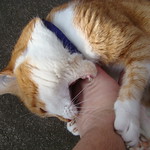Introduction: Unraveling the Mystery of Feline Biting Behavior
Cats are beloved companions known for their playful antics and affectionate nature. However, there are times when their behavior can take a surprising turn, leaving their human counterparts with a painful nip or bite. But what motivates cats to resort to biting? In this comprehensive exploration, we’ll delve into the various reasons why cats bite, uncover common triggers for this behavior, and discuss effective strategies for managing and preventing biting incidents in our feline friends.
Understanding Feline Behavior: The Complex World of Cats
To comprehend why cats bite, it’s essential to understand the intricate nuances of feline behavior. Cats are highly intelligent and independent creatures with their own unique personalities and communication styles. Biting is one of the many ways that cats express themselves and interact with their environment, whether it’s during play, socialization, or as a means of communication.
Types of Cat Biting: Playful vs. Aggressive
Not all cat bites are created equal – there are distinct differences between playful biting and aggressive biting. Playful biting typically involves gentle mouthing or nibbling, often accompanied by relaxed body language and a wagging tail. This type of biting is a natural behavior for kittens, who use it as a way to explore their surroundings and interact with their littermates.
On the other hand, aggressive biting is characterized by sharp, sudden bites delivered with intent to harm or defend. Aggressive biting may occur in response to perceived threats, fear, or frustration, and can result in injury to humans or other animals. Understanding the underlying motivation behind a cat’s biting behavior is crucial for addressing the issue effectively.
Common Triggers for Cat Biting: Identifying the Culprits
Cat biting can be triggered by a variety of factors, ranging from playfulness and overstimulation to fear and territorial aggression. Some common triggers for cat biting include:
- Playfulness: Cats, especially kittens, may engage in playful biting as part of their natural behavior. They use their teeth and claws to simulate hunting and practice essential skills such as stalking and pouncing. While playful biting is typically harmless, it’s essential to establish boundaries and redirect this behavior towards appropriate toys or objects.
- Overstimulation: Cats are sensitive creatures that can become overstimulated or overwhelmed by excessive petting or handling. When cats reach their threshold for stimulation, they may respond with biting or swatting as a way to communicate their discomfort and assert boundaries. Learning to recognize the signs of overstimulation, such as flattened ears or twitching tails, can help prevent biting incidents.
- Fear and Anxiety: Cats may resort to biting as a defensive mechanism when they feel threatened or anxious. Common triggers for fear-based aggression include loud noises, unfamiliar people or animals, and changes in their environment. By addressing the underlying cause of their anxiety and providing a safe, secure environment, pet owners can help alleviate their cat’s stress and reduce the likelihood of biting.
- Territorial Aggression: Cats are territorial animals that may defend their territory against perceived intruders, whether they’re other cats, animals, or humans. Biting may occur during territorial disputes or when a cat feels their space is being invaded. Providing cats with plenty of vertical territory, such as cat trees or shelves, can help alleviate territorial tensions and reduce the risk of aggression.
Managing Cat Biting: Tips for Preventing and Redirecting Behavior
While occasional biting may be a natural behavior for cats, it’s essential to address any problematic biting habits to prevent injury and promote harmonious relationships with our feline companions. Here are some strategies for managing cat biting:
- Provide Enrichment: Ensure that your cat has plenty of mental and physical stimulation to prevent boredom and frustration. Interactive toys, puzzle feeders, and regular play sessions can help satisfy their natural hunting instincts and reduce the likelihood of biting out of boredom.
- Establish Boundaries: Teach your cat appropriate behavior by setting clear boundaries and providing consistent consequences for biting. Use positive reinforcement techniques, such as praise and treats, to reward good behavior and discourage biting. Avoid rough play or encouraging biting behavior with hands or feet.
- Redirect Behavior: When your cat exhibits biting behavior, redirect their attention towards appropriate toys or objects. Offer interactive toys, scratching posts, or food puzzles to provide an outlet for their energy and redirect their natural instincts towards more acceptable outlets.
- Use Deterrents: In cases of aggressive biting or territorial aggression, consider using deterrents such as citronella sprays or noise-making devices to discourage unwanted behavior. These deterrents can help interrupt the biting sequence and discourage repeat incidents.
- Seek Professional Help: If biting behavior persists despite your best efforts, seek guidance from a veterinarian or animal behaviorist. They can conduct a thorough evaluation of your cat’s behavior and provide personalized recommendations for managing and modifying their biting habits.
Conclusion: Navigating the Complexities of Feline Behavior
In conclusion, cat biting is a multifaceted behavior that can stem from a variety of factors, including playfulness, overstimulation, fear, and territorial aggression. By understanding the underlying motivations behind cat biting and implementing effective management strategies, pet owners can foster positive relationships with their feline companions and ensure their well-being. Through patience, consistency, and a deep understanding of feline behavior, we can create a safe and harmonious environment where cats and humans can coexist peacefully.
